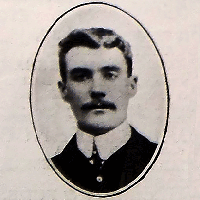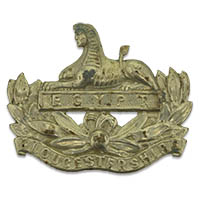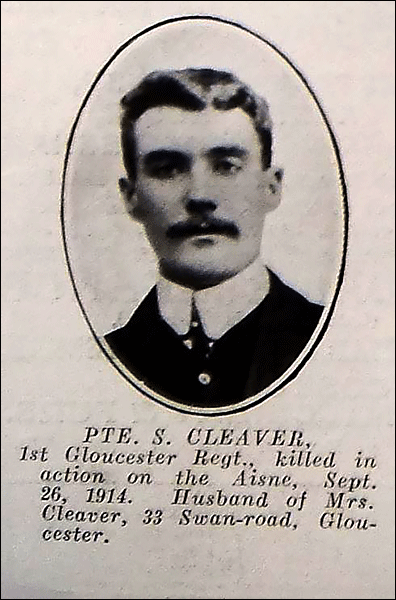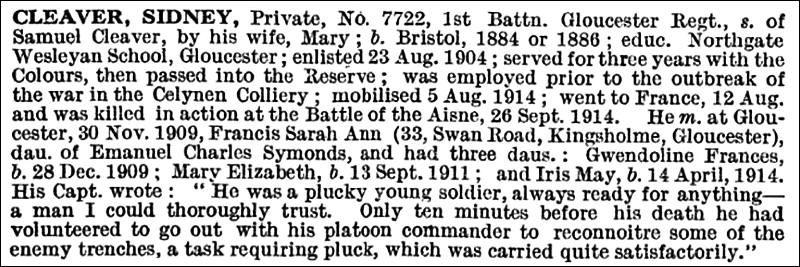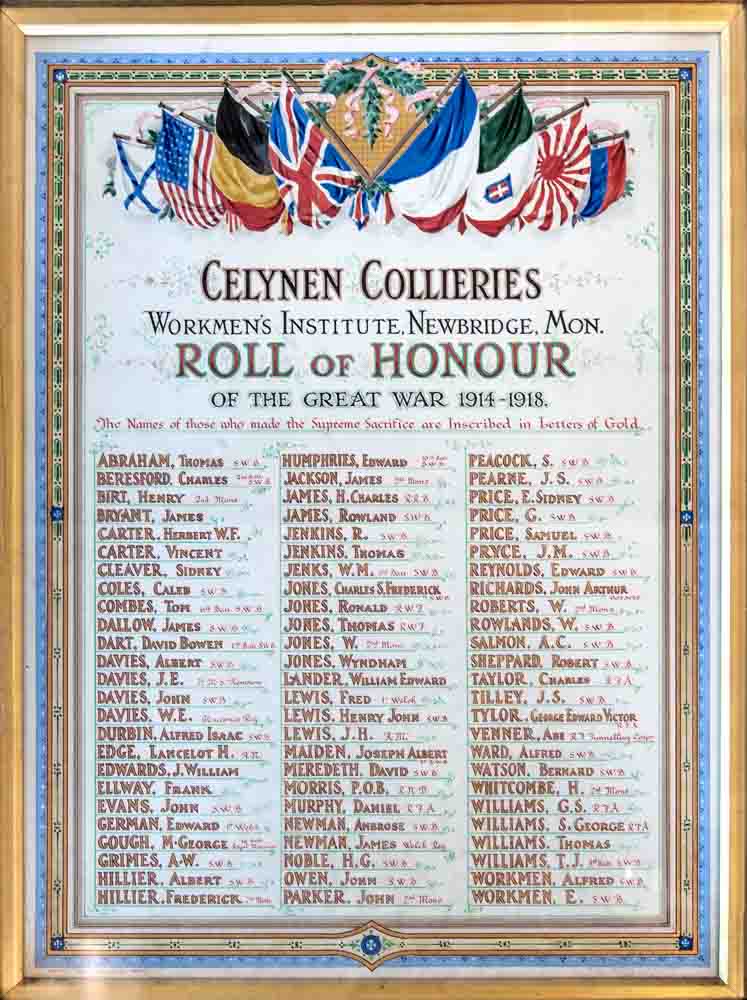| Unit/Regiment | Gloucestershire Regiment |
| Battalion | 1st |
| Rank | Private |
| Service Number | 7722 |
Theatre of War first served in | (1) France |
| Date of entry therein | 16/08/1914 |
| Age at Death | 26 |
| Date of Death | 26/09/1914 |
| Burial/Memorial Reference | La Ferte-sous-Jouarre Memorial |
| CWGC Family Details | Husband of F. S. A. Aylmer (formerly Cleaver), of 33, Swan Moad, Kingsholm, Glos. |
| SDGW – Where Born | Bristol |
| Enlisted | Gloucester |
| Resided | Newbridge Mons. |
| How Died | Killed in action |
| Theatre of War | Western European Theatre |
| Medal Entitlement | 1914 Star with Clasp -indicating his unit was operating within range of the enemy mobile artillery betwewen 5th Aug and 22nd Nov 1914
British War Medal
Victory Medal |
| Notes | Commemorated on the Celynen Collieries Roll of Honour |
Family
Sidney Cleaver was born around 1888 in Bristol, the son of Samuel and Mary Cleaver. He was educated at the Northgate Wesleyan school in Gloucester.
Mary Cleaver became widowed in 1891 when Samuel died at just 35 years of age, she remarried in 1897 to James Henry Beazer who was nearly twenty
years her senior. In the 1901 Census Sidney is living with them at 1 Barbican Gardens, Gloucester and was listed as the stepson of James Beazer.
On 23rd August 1904 Sidney enlisted into the Army and joined the Gloucestershire Regiment with the regimental number 7722. He served for
three year with the Colours and then passed into the reserves. Sidney Cleaver married Frances Mary Ann Symonds on 30th November 1909 and went
on to have three daughters; Gwendoline Frances b 28th Dec. 1909, Mary Elizabeth b 13th Sept. 1911 and Iris May b 14th April 1914. After the
birth of their first daughter, Gwendoline, the family moved to Newbridge where they were boarders at 3 Greenfield. They lived with Frank
White and his family along with a further three boarders. Sidney was employed as a Coal Hewer at the Celynen colliery.
Military
After the declaration of war on 4th August 1914 the British army needed to mobilise as quickly as possible in an attempt to get to France in
time to stop the German advance. Sidney Cleaver had been a regular soldier and was still a reservist so he was one of the very first men to
be recalled into the army. On 5th August 1914 public notices in the press, Post Offices, Police stations etc. would have instructed him to
report to his regimental depot. Upon showing his Army identity paper he would have been given five Shillings subsistence money at the local
Post Office and the ticket office at his local railway station would have provided him with a ticket to Bristol, where the Gloucester Regiment
depot was located. With other 1st Battalion reservists he would then have proceeded to Borden (near Aldershot) by train followed by a couple
of days marching to break in new boots and some rifle practice.
In the early hours of the morning on 12th August the battalion boarded two trains at Bordon station headed for Southampton docks. The first
train, carrying A & B Companies, arrived at 5 a.m. and the second, carrying C & D Companies and the Machine Gun Section came in 90
minutes later. The battalion then proceeded to board the ‘Gloucester Castle’ for the journey to Le Havre. The first casualty of the campaign was
recorded when one of the draft horses sustained a head wound during embarkation.
The battalion was soon in action in a number of the iconic battles of 1914. On 23-24th August they fought at the battle of Mons and on 27th
August they were involved in the Readguard action at Etreux. From 7th-10th September 1914 they were at the Battle of the Marne and between
12th-15th September they fought in the Battle of the Aisne including the capture of the Aisne Heights. They saw action again on 20th September
in the actions of the Aisne Heights.
Sidney Cleaver was killed in the action of Chivy on 26th September. The 1st Battalion War Diary records that his unit was not involved in
any great attack or defence on the day although other units around them were, rather he became one of the many casualties of the war who
were killed in their trenches whilst being shelled by enemy artillery
